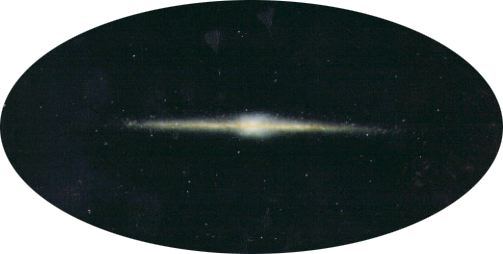

![]()
Our `local' star, the sun, is one of about 100 thousand million stars clustered together into a galaxy (the Milky Way), held together by gravity. But the stars alone could only give about one-tenth of the gravitational force needed to hold the galaxy together - so, much like an iceberg, nine-tenths of the galaxy is completely invisible!
The unseen nine-tenths is `dark matter', and as yet unidentified.
There are a number of plausible possibilities:
There is evidence that such objects may account for about one-quarter of the dark matter in our galaxy.
We don't know their masses - or even if they have a mass; but a mass of a few hundred-millionths of a hydrogen atom's mass could account for all the dark matter.
Direct detection is not (yet) feasible; experimental effort is directed towards determining neutrino masses.
The dark matter may consist of two or more of the above, for example a mixture of MACHOs and WIMPs.
The aim of our collaboration is to detect WIMP dark matter.
Collisions between WIMPs and target atoms are little different to billiard ball collisions: the WIMP changes direction, and slows down a little; the atom recoils. This recoil can be detected in three ways:
We use technique (b), with the light detected by photomultiplier tubes. Up to now, we have been using sodium iodide crystals; in the future we shall also be using liquid xenon, with which it should be possible to obtain much greater sensitivity, using a combination of scintillation and charge collection (a).
If WIMPs are the bulk of the galactic dark matter, about a million of them pass through every square centimetre every second, travelling at hundreds of kilometres per second. Shouldn't they be easy to detect?
`Weakly Interacting' means that WIMPs collide very rarely: fewer than one per day will hit an atomic nucleus in a 10 kilogram detector. Meanwhile, we are also being bombarded by cosmic rays - fewer in number, but interacting much more readily. To reduce the unwanted `background noise' from these cosmic rays, our experiment is being carried out in caverns in salt 1100 metres below ground at the bottom of Europe's deepest mine, at Boulby, North Yorkshire. At this depth, collisions in the rock have stopped all but one in a million of the cosmic rays; meanwhile, of the thousand million WIMPs a second passing through you, only about three collide in the rock on their way down - and they are only slowed down a little, not stopped.
Unfortunately, going deep underground isn't enough to get rid of all the `noise'. Most materials - including the rock walls of the caverns, and the people working there - contain minute traces of natural radioactive atoms, which give out particles whose collisions would also give rise to `noise' in our detectors. These particles are absorbed, as far as is feasible, in high purity shields of either water (by immersing detectors in a tank containing 200 ton(ne)s of pure water) or lead, copper, and wax or polythene. Radioactivity in the detectors themselves must also be minimized, by careful selection of materials (which has involved a lengthy and expensive testing programme). It has not been possible to produce photomultiplier tubes with radioactivity as low as the other detector components, so the scintillator must be shielded by use of silica `light guides' or, as in the model, by a pure liquid (such as paraffin) which transmits the light flashes from the sodium iodide crystal.
Despite these efforts, the `signal' rate from dark matter will probably be only one-hundredth to one-thousandth of the radioactivity `noise' rate. So, to obtain the sensitivity we need, we must be able to distinguish the unwanted `background' from events produced by nuclear recoils. In both sodium iodide and liquid xenon this is possible because the two kinds of events produce distinguishable light pulses: background events can be rejected by `pulse shape discrimination'.
These experiments are a response to the following basic questions:
If dark matter can be detected and identified, it may help to answer several of the most important currently unanswered questions in fundamental physics.
The UK Dark Matter Collaboration comprises about 20 physicists, together with engineering and other support, from:
Our work is funded by the Particle Physics and Astronomy Research Council.
We have also received generous support from Cleveland Potash Ltd, who have not only provided the site and the necessary infrastructure for the experiment but have also tolerated the disruption from journalists and TV producers wishing to report on this novel experiment.
Efficient light collection is crucial, for two reasons:
Computer simulations show that the `liquid-coupled' system shown in the model will give a substantial improvement.
Light flashes from the sodium iodide crystal (the central cylinder) are reflected and guided by the liquid (paraffin) to be detected by the large photomultiplier tubes at the top of the container. (Simulated light flashes may be provided)
The detector vessel is shown partially surrounded by (working outwards):
The model is full size, and the veto and shields would completely surround the detector and extend over the top.
j.d.lewin@rl.ac.uk - April 28th, 1997URL: http://hepwww.rl.ac.uk/ukdmc/pop/galactic-dm-exhibit.html